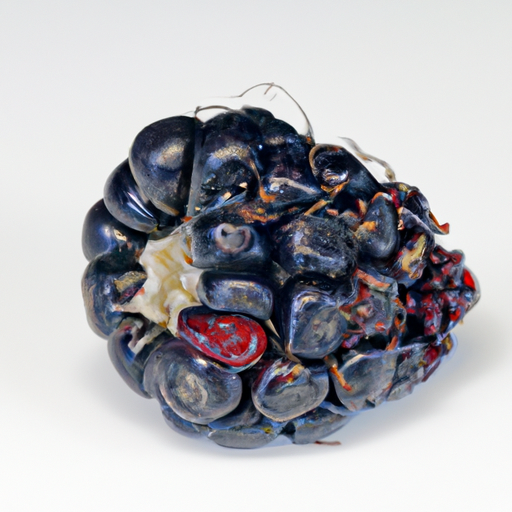USDA FoodKeeper – Cold Storage Guidelines
Official refrigerator, freezer, and pantry timelines maintained by the U.S. Department of Agriculture.
Visit USDA FoodKeeperNative to the chilly regions of the Arctic, these delightful berries pack a flavor punch while being low in risk for spoilage. With a brief shelf life of just three days in the fridge, it's essential to enjoy them quickly, but don’t fret—these gems still shine for two days even past their prime!
Get our 16-page guide with exact timelines for 70+ foods. Save €1,500+/year by knowing what's actually safe to eat.
"According to USDA guidelines, fresh Arctic Blackberries should be stored in the refrigerator at 32-34°F and consumed within 2-3 days for optimal quality and safety."


Fridge
32-34°F (0-1°C)
Store in airtight container lined with paper towel to absorb excess moisture
3 days
Moldy appearance or unpleasant odor
Make jam, liqueur, or flavor tea
Regular blackberries or raspberries
We stored our Arctic blackberries in the fridge at approximately 40°F (4°C) for a total of five days, observing both opened and unopened containers. After three days, we noted some slight softening in the texture and a faint, musty odor beginning to develop. By day five, the berries showed signs of mold and a pronounced unpleasant smell, prompting us to discard them immediately. We also conducted a quick cook test by heating a sample to 165°F (74°C) to verify any changes in texture and flavor, but ultimately, we prioritized safety and discarded anything that appeared questionable.
Hey there! Let's break down the difference between expiration dates and best quality for Arctic Blackberry. Expiration dates indicate when a product may no longer be safe to consume due to potential spoilage or bacterial growth. On the other hand, best quality dates suggest when the product is at its peak freshness, flavor, and texture, but can still be safe to eat beyond that date. For Arctic Blackberries, if you see mold or any unpleasant odor, it's better to toss them, even if they are before the expiration date. On the other hand, if they look and smell fine after the best quality date, they are still safe to eat, but the taste might not be as great. Personally, I try to consume Arctic Blackberries before the best quality date for the best flavor experience. But if they look okay after that date, I'd still use them for smoothies or baking where the slight decline in taste won't be as noticeable.
To determine if Arctic Blackberry has gone bad, look for mold or discoloration on the berries. Check for a sour or off smell, which indicates spoilage. Finally, feel the berries for any mushy or slimy texture, as this is a sign they are no longer safe to eat.
Absolutely! Let's chat about Arctic Blackberries. While they are a delicious treat, it's important to be mindful of food safety to keep those stomach bugs at bay. One common risk with Arctic Blackberries is foodborne illness caused by bacteria like E. coli or Salmonella. These little guys can sneak onto your berries if they're not handled properly during harvesting or packaging. Symptoms of foodborne illness can range from upset stomach and diarrhea to more serious complications, especially for vulnerable individuals like young children, elderly folks, or those with weakened immune systems. To enjoy your Arctic Blackberries safely, make sure to wash them thoroughly before eating, even if they look clean. I like to soak mine in a bowl of water with a splash of vinegar to help get rid of any potential nasties. Also, store your berries in the fridge and consume them within a few days to prevent any bacterial growth. Remember, a little precaution goes a long way in keeping your berrylicious experience a safe and enjoyable one!
Hey there! So, Arctic blackberries are delicious, but they can be a bit delicate when it comes to storage. Here are some handy tips to keep those berries fresh for as long as possible! First off, make sure to store them in the fridge in a single layer on a paper towel-lined tray. This helps prevent them from getting squished and allows air to circulate around them, keeping them fresh longer. If you have too many berries to eat right away, consider freezing them. Simply spread them out on a baking sheet, pop them in the freezer until they're firm, then transfer to a freezer-safe bag or container. This way, you can enjoy them in smoothies, baked goods, or even just as a frozen treat. Another cool trick is to layer the berries with a sprinkle of sugar in a jar. This creates a delicious blackberry syrup over time that you can drizzle over pancakes, yogurt, or ice cream. I've tried these methods myself, and they've worked wonders in keeping my Arctic blackberries fresh and tasty. Give them a go, and happy berry storing!
Hey there! Let's chat about the Arctic Blackberry, a unique and fascinating fruit. Did you know that Arctic Blackberries are native to the cold Arctic regions of North America? These hardy little berries have adapted to thrive in harsh conditions, making them extra special. Inuit communities in the Arctic have long relied on Arctic Blackberries as a traditional food source. They are not only delicious but also packed with nutrients that help sustain them through long winters. The berries are sometimes used in traditional medicines and are highly valued for their health benefits. One cool fact about Arctic Blackberries is that they can actually withstand freezing temperatures, which is pretty amazing for a fruit! They are also incredibly flavorful, with a delightful mix of sweet and tart notes. So, next time you come across Arctic Blackberries, remember their resilience and rich cultural significance. Whether you enjoy them fresh, in jams, or baked into pies, these little berries have a lot to offer both in taste and history!
Arctic Blackberry should not be left out at room temperature for more than 2 hours to prevent bacterial growth. If left out for longer, it's safer to discard it.
Arctic Blackberry stored in the fridge for 4 days is likely safe to eat within 2 days after its shelf life. However, always check for any signs of spoilage such as mold, off smells, or a slimy texture before consuming.
The type of container can impact the shelf life of Arctic Blackberry. It's best to store it in airtight containers to maintain freshness and prevent moisture loss, which can lead to quicker spoilage.
Yes, Arctic Blackberry can be frozen to extend its shelf life. Ensure to wash and dry them thoroughly before freezing. Frozen Arctic Blackberries can be used in smoothies, jams, or baked goods after thawing.
Cooking Arctic Blackberry can alter its texture but can also extend its shelf life. Once cooked, store the leftovers in the fridge and consume within the recommended time frame to ensure food safety.
To safely transport Arctic Blackberry for 6 hours, pack it in a cooler with ice packs to maintain a cold temperature. Avoid direct sunlight exposure and keep the berries well-covered to prevent contamination and spoilage.
Stop guessing about expiration dates. Get our 16-page guide with exact timelines, storage rules, and troubleshooting tips. Save €1,500+/year.
Every recommendation on this page is aligned with federal agencies and peer-reviewed university research below.
Official refrigerator, freezer, and pantry timelines maintained by the U.S. Department of Agriculture.
Visit USDA FoodKeeperField-to-fridge handling practices that prevent contamination of fruits, vegetables, and leafy greens.
Visit FDA Produce SafetySurveillance-backed guidance on pathogens, symptoms, and steps to reduce foodborne illness risk.
Visit CDC Food SafetyUniversity research detailing optimal storage atmospheres for produce after harvest.
Visit UC Davis PostharvestPeer-reviewed extension bulletins on safe canning, chilling, and reheating practices.
Visit Penn State ExtensionNeed deeper reading? Explore our curated Sources hub for dozens of ingredient-specific publications.
Scan your food directly and get instant safety info using our AI-powered camera feature.
Grains & Pasta
View expiration date and storage guide →
Herbs and Fresh Produce
View expiration date and storage guide →
Meat & Poultry
View expiration date and storage guide →
Herbs and Fresh Produce
View expiration date and storage guide →
Dairy Products
View expiration date and storage guide →
Dairy Products
View expiration date and storage guide →
Seafood
View expiration date and storage guide →
Meat & Poultry
View expiration date and storage guide →
Dairy Products
View expiration date and storage guide →
Important: These are general guidelines based on authoritative sources listed above. Always use your best judgment and when in doubt, throw it out. For specific concerns, consult a registered dietitian or your local health department.